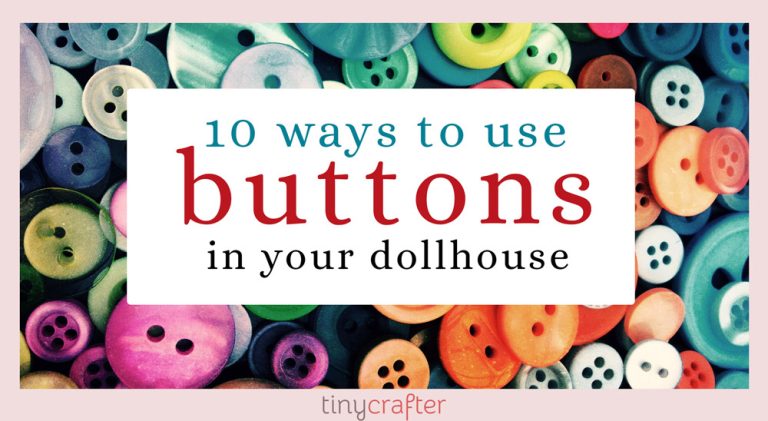How to Paint a Dollhouse

Painting a dollhouse seems to be easy until you actually go to do it! In this post I’ll share all my best tips for how to paint a dollhouse, plus recommendations for the best type of dollhouse paint to use.
Whether you’re building a new dollhouse from a kit that needs painted or you are giving an old dollhouse a fresh new look, these tips for how to paint a dollhouse will make the process a lot more fun and easy!
What Paint is Best for a Dollhouse?
The first thing you need to consider when painting is the type of paint you plan to use.
Latex paint, which is the same kind of paint you would use on the interior of your real house – is the perfect choice because it is economical and you can get it in almost any color.
Latex paints come in a variety of different formulas, so it’s important you get the right formula so it’s not too glossy. The best choices for paint for a dollhouse include eggshell, satin, and semi-gloss.
I personally prefer eggshell and satin so the walls do not look too glossy, but if you want a glossy finish, the semi-gloss is a great choice because it’s also the most durable over time.
Note that you won’t likely need an entire gallon of paint for your dollhouse. In most cases, a quart of paint is sufficient!
I sometimes will buy a gallon simply because it’s around the same price, but a quart of paint is much easier to handle for pouring out small amounts of paint.
While latex is my first choice for things like dollhouse walls, trim pieces and the base, I also use a lot of acrylic craft paints. Acrylic craft paints aren’t quite as economical as the latex paints, but they definitely can be used in the same ways.
Most often I use acrylic craft paint when painting my dollhouse furniture, because it’s easier to manage for small projects. However, it will stick to any wood surface, though you’ll want to first use a coat of primer or gesso.
Should You Varnish A Dollhouse?
It is usually not necessary to varnish a dollhouse when you are using latex or acrylic paint. Varnish can sometimes cause colors to be cloudy, so unless your plan was to put it outside to be exposed to rain and the elements, I would skip the varnish all together.
In addition to paints, you may sometimes want to use wood stain for different parts of your dollhouse.
What To Use for Shingles and Floors?
Shingle dye is the best choice for wood shingles, as paints or even some wood stains may cause the thin shingles to curl. Shingle dye is specially formulated so you don’t have to worry so much about the shingles warping.
For wood floors, wood stain is an option. Most manufacturers recommend a one-coat water-based stain such as Minwax Polyshades.
In general, you do not want anything oil-based for your dollhouse. This is just adding a lot of extra work!
Supplies For Painting a Dollhouse
Painting a dollhouse doesn’t require a whole lot of supplies, but it is important you have the right supplies and tools for the job!
Here’s what you’ll need:
A mini paint roller and tray: A mini paint roller and tray will make your life a lot easier for flat surfaces such as interior walls! You can get them in 3-inch or 4-inch sizes.
Foam Paint Brushes: If smooth surfaces are important to you, foam paint brushes will make it easier to avoid brush strokes from showing in your dollhouse.
Regular Paint Brushes: Regular small paintbrushes can be used if you want to give the paint a bit of texture. Whether you’re going for plastered walls or want a faux wood grain, regular brushes are great for this.
Paint of Your Choice: In most cases, this should be a latex-based paint with an eggshell, satin, or semi-gloss finish. Acrylic paints can also be used.
Superfine Sandpaper: Any grit over 240 should be sufficient. The higher the number with sandpaper, the finer it will be.
Microfiber/Tack Cloths: These are great for picking up dust particles from sanding and preparing the surface before you paint or stain.
Painter’s Tape: Painter’s tape is useful for a number of applications. It can be used to hold pieces together while gluing, or they can also be used to cover areas you do not want to paint when you are painting two different colors together.
Paper Towels & Baby Wipes: These are great for cleaning up any spills!
Most of these supplies are readily available in any home improvement store where they also sell the paint you’ll need. You can usually get everything all at once!
Now that we’ve covered the basic supplies, let’s get into setting up your workspace.
How to Set Up Your Painting Workspace
When you start painting your dollhouse, it’s important that you’re organized so that you know exactly what needs to be painted, as well as have enough room for laying things out to dry if you are working with a new dollhouse kit.
Ask yourself: Do you have enough table space? Having large tables set up can give you lots of room to work as well as lots of space to lay out the larger pieces while they dry.
If you do not have enough table space, it can be helpful to use a folding card table even if just temporarily.
If the weather is nice, you can also opt to paint everything outside. This only works however if you have a sunny day without too much wind.
Before you start painting, you’ll also want to make sure you’ve organized your pieces. You do not want to accidentally paint the wrong things, such as the roof!
You will, however, want to paint the interior ceiling before the dollhouse is assembled. It just makes life much easier!
I like to start with small pieces at a time. Don’t try to paint everything all in one go!
Now that we’ve covered how to set up your workspace and you have all your supplies, you are ready to paint!
How to Paint a Dollhouse
Step 1: Remove Anything You Can That You Don’t Want Paint On
This step mostly applies to painting a dollhouse that is already assembled. For example, you may want to remove window panes or any other pieces made of plexiglass.
If removing this isn’t possible, you will instead want to use painter’s tape to carefully mask off any areas you do not want to get paint on!
Step 2: If Building a Kit, Follow the Directions!
In some dollhouses I’ve assembled, the directions said not to paint until everything was together. In others, it recommended painting everything first.
While it’s not a make-or-break deal whether you paint before or after the house is assembled, sometimes it is easier to do it one way or the other, depending on the style of the house.
If your directions with your dollhouse kit say to paint it first, paint it first! If the directions say to assemble it before painting, assemble it before you paint!
Step 3: Apply a Primer or Base Coat
Your first coat of paint is going to be absorbed into the wood and not look very good at all. Fortunately, you can simply use primer in this step. They make spray-on primers, but I personally prefer to apply primer using a foam brush.
Step 4: Sand The Area You Just Primed
Every time you paint, you’ll want to lightly sand the area. This is the secret to a smooth finish. Be sure the paint is 100% completely dry and that you’ve allowed at least a few hours between painting and sanding.
Use fine-grit sandpaper. 240 is the lowest grit of paper I would use – I like to use the superfine papers that range from 600-1200 and are often used for autobody work.
You do not want to sand the paint off, you simply want the surface to be smooth.
After you sand, run the microfiber tack cloth over the surface to remove any dust particles.
Step 5: Paint the Walls!
Paint the walls of the dollhouse by using either a foam brush or a mini paint roller. The mini paint roller can go a bit faster, but it’s not ideal for hard-to-reach spaces. The most important thing is you get the finish that you desire.
Be sure you allow the walls to fully dry and set for several hours.
Step 6: Repeat Steps 4-5
If you primed or applied a base coat in step 3, you may not need to sand and apply a second or third coat of paint. However, it depends on the brand of paint you are using and the desired finish you want.
If you decide that you need another coat of paint, simply repeat steps 4 and 5. The basic rule is you should always sand between coats of paint. This will give you the smoothest and most professional-looking result.
Your final coat of paint should not be sanded!
Additional Tips for Painting a Dollhouse
Now that you know the basics of painting a dollhouse, here are some additional tips to ensure your success!
Work From Top to Bottom: This will help avoid any potential drips.
Watch for Drips & Wipe Them Up Right Away! Drips happen, especially if you are painting a dollhouse that’s already been assembled. If you spot any drips, they can usually be wiped up quickly with a paper towel or baby wipe.
A Thin Coat of Paint is Better Than a Thick One: It’s better to have to apply multiple coats of thin layers of paint than to apply the paint too thick.
Use Smaller Brushes For Hard to Reach Spots: The smaller the spot you are painting, the smaller the brush should be!
Don’t Paint Any Areas You’ll Be Gluing or Staining: Stain will not work very well over paint, and glue sticks better to wood than it would paint.
I hope these tips for how to paint a dollhouse are useful for you! Do you have any tips you’d like to share? Anything you’d like to add? Tell us in the comments section below!







This was so informative, thank you! Any special tips on doing a house that is already done but needs a renovation? Nothing can come apart and everything is already wallpapered and painted both inside and out. Floors are thankfully unfinished and only marked with paint splatters and roof is still good. I have never done this before and could use some advice, thanks!
Hi Beth, it can be tricky to paint a dollhouse that’s already together, but as long as you use a small brush in the corner areas it is definitely possible!
Hi there I have 2 dollhouses I’m trying to update. I’m excited to get started but kind of overwhelmed at same time! Lol
Questions do I need to sand the old paint before I prime?
When in doubt, it’s always better to sand!
I am painting a dollhouse to be a superhero house for my grandson. After applying multiple coats of paint do I need to put a top sealant coat on the paint?
Hi Tina,
Depending on how old your grandson is, a top sealant would be a great idea because it will help it withstand hours of play without being scratched. Some type of sealant or varnish will also help make it a lot easier to clean!
Hello! Im new and would just like to say thank you for all the information it comes in handy. The one question I have is can you recommend a brand specifically a primer that I can use for my doll house?
I don’t have a specific brand – I’ve used cheapie primers that work just as good as the more expensive ones! The real key is just lightly sanding in between all of the coats!
Thanks for this post, I’m going to take a stab a painting a 30yo fully assembled wooden house that has never been painted, shingled roof old victorian style. Any tips on where I can find inexpensive (or better even- free) furniture and dolls for this project? Trying to get it all done before Christmas for my 2 granddaughters. Thanks!
I have a kid Kraft dollhouse(mdf fabric) is what it’s says it’s made of. I want to convert it to a boys Star Wars house. What kind of paint would I use? I don’t really know what mdf fabric is. Material seems like a cross between wood and plastic.
Hi Michelle! MDF is a type of manufactured wood product that means Medium Density Fiberboard. Many very popular dollhouse companies use MDF, even Real Good Toys. The Kid Kraft Dollhouses usually have a plasticy-vinyl coated sticker on top of the wood. You can paint over it directly with any kind of multi-surface paint that’s meant for painting plastic (I’m a big fan of Folk-Art Multi-surface paint!) – but you could also optionally sand off the stickers to the point they aren’t glossy anymore (it’s okay if you get to the “papery part of it) and then paint it with a primer or gesso and then paint it with any paints you like!
Thankyou for your tips I want to paint a dolls house that is already painted but am unsure what paint to use it will be used by quite young children so need to make sure it’s safe can you please advise ?
Hi Charlotte! Most acrylic paints are non-toxic – if you have any questions about a specific paint I’d recommend looking up the manufacturer’s safety info and recommendations – that’s the best way to know for sure!
Hello!
I bought an already assembled dollhouse from Real Good Toys- and was wondering if I needed to sand the wood before I prime, and then paint it ?
also, if I’m using acrylic paint to paint the entirety of the dollhouse, do I still need to sand and prime ?
Thank you!!
Hi Lexie! Sanding and priming is always a good idea for any kind of paint because this will help you get a nice smooth finish! Priming will also help save on the anount of paint you will need because you would otherwise need a lot of coats of paint!